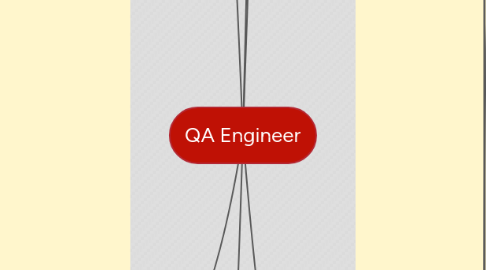
1. New part
1.1. Customer request
1.1.1. Planning
1.1.1.1. R&D (D-FMEA)
1.1.1.1.1. Drawing issue
1.2. Inspection machine
1.2.1. New machine setting
1.2.1.1. Machine SPEC
1.2.1.1.1. Base current machine + Change point
1.2.1.1.2. Structructer (Module)
1.2.1.1.3. Software
1.2.1.2. Making condition
1.2.1.2.1. Indication Deviation (σ)
1.2.2. Accuracy machine
1.2.2.1. GRR
1.2.2.2. Soukan & Indication accuracy
1.2.2.2.1. ERR Deviation
1.2.2.2.2. R2>0.9 (Linear)
1.2.2.3. Daily master check
1.2.3. Master making
1.2.3.1. Sample (上、中、下)→ Original Machine
1.3. PPAP
1.3.1. Control Plan&Process flow
1.3.2. PIS
1.3.2.1. Critical Items
1.3.2.1.1. Function
1.3.2.1.2. Dimension
2. Change project
2.1. Judge & complete survey
2.1.1. Brain storming
2.1.1.1. Structure&Function
2.1.1.2. Process flow & PCP
2.1.1.3. FTA&FMEA
2.1.1.4. Kakotora
2.1.2. Having ESC
2.1.2.1. Quality concern & corrective actions
2.1.3. No ESC
2.1.3.1. Base on criteria item
2.1.3.2. Actual exp.
2.1.3.2.1. FTA&FMEA
2.1.3.2.2. Kakotara
2.2. Quality Standard
2.2.1. Quality thinking (FTA&FMEA)
2.2.1.1. Initial Evaluation
2.2.1.1.1. Sample: Q'ty & condition
2.2.1.1.2. Function test
2.2.1.1.3. Tear down test
2.2.1.2. Process preparation
2.2.1.2.1. Process window
2.2.1.2.2. Cpk
2.2.1.2.3. OR
2.2.1.2.4. 2DR
2.2.1.2.5. Test run
2.2.1.2.6. Maxtry
2.2.1.3. Durablity test
2.2.1.3.1. Test Type
2.2.1.3.2. Sample condition
2.2.1.3.3. Book test equip.
2.2.2. Stick to schedule
2.2.3. Control other section test
2.3. PCR submitting
2.3.1. Yes
2.3.1.1. List up cus.
2.3.1.1.1. Filling PCR form
2.3.1.2. 5M1E summary
2.3.1.3. Follow process preparation
2.3.1.3.1. Make&stick to plan
2.3.1.3.2. Poin out date for doc. complete
2.3.1.3.3. Alarm as necessary
2.3.2. No
2.3.2.1. Judge criteria
2.3.2.1.1. SQAM (example)
2.3.2.1.2. Send&get DNJP's feedback
2.4. PPAP submission
2.4.1. Plan approval & require doc.
2.4.1.1. PPAP to other sections
2.4.1.1.1. PE
2.4.1.1.2. PI&DC
2.4.1.2. Making QA doc.
2.4.1.2.1. Initial result
2.4.1.2.2. Process flow & MQC (if any)
2.4.1.2.3. Durablity test
2.4.2. Final approval
2.5. Making report
2.5.1. Collect data (Per QS)
2.5.1.1. Initial&Durability test
2.5.2. Making form
2.5.2.1. Compare&evaluate
2.5.2.1.1. Verify & adjust
2.5.3. Complete&Report
2.6. Stratification sheet
2.6.1. List customer
2.6.2. Grasp retail product
2.6.3. Collect infor 1st Lot
2.6.3.1. Quantiy
2.6.3.2. ETD&ETA
2.6.4. Issue stratification sheet
2.6.5. Inform to cus.
3. Other
3.1. Boundary sample making
3.1.1. For no specify SPEC items
3.2. Review P-FMEA & QA-Net
3.2.1. Instrucion & actual exp.
4. Defect investigation
4.1. Occur & flow out cause meaning
4.2. Part's information
4.3. Appearance inspect&take picture
4.3.1. Contamination
4.3.1.1. FTIR analysis
4.3.1.2. SEM analysis
4.3.1.3. Compare with current material
4.3.2. Damage
4.3.2.1. Cause (FTA&FMEA)
4.3.2.1.1. 5M1E&P-Chart invest
4.3.2.1.2. Process invest
4.3.2.1.3. Re-occurence test
4.3.2.1.4. Occur&flow out cause
4.4. Function check
4.4.1. NG
4.4.1.1. Cause (FTA&FMEA)
4.4.1.1.1. 5M1E&P-Chart invest
4.4.1.1.2. Process invest
4.4.1.1.3. Re-occurence test
4.4.1.1.4. Occur&flow out cause
4.4.1.1.5. Countermeasure
4.4.2. OK
4.4.2.1. Complete report
5. Basic knowledge
5.1. Product's structure
5.2. Process flow
5.2.1. MQC
5.3. QA Thinking
5.3.1. FTA
5.3.2. FMEA
5.4. PDCA
5.4.1. Meaning
5.4.2. How to plan
5.5. Process capacity
5.6. Foreign language
6. QC Basic
6.1. Importance of quality
6.1.1. Concept of quality
6.1.2. Quality problems & effects
6.2. Concept of quality control
6.2.1. What is Quality Control?
6.2.1.1. Concept of quality
6.2.1.2. Concept of control
6.2.1.2.1. Fact control
6.2.1.2.2. Management cycle
6.2.1.2.3. Priority Oriented
6.2.1.2.4. Process control
6.2.1.2.5. Variability control
6.2.1.2.6. Recurrence prevention
6.2.1.2.7. Standardization
6.3. Statistical Quality Control Methods
6.3.1. 7 QC Tools
6.3.1.1. Pareto chart
6.3.1.2. Cause & effect diagram
6.3.1.3. Strafification
6.3.1.4. Checksheet
6.3.1.5. Historgram
6.3.1.6. Scatter diagram
6.3.1.7. Graphs/Control Charts
6.3.2. QC and data
6.3.2.1. Variability
6.3.2.2. Type of data
6.3.2.2.1. Measured value
6.3.2.2.2. Countable values
6.3.2.3. Requirements of data used for QC
6.3.2.4. Populations & Samples
6.3.2.5. Data sampling method
6.3.2.6. Types of Variation
6.3.2.6.1. Systemmatical error
6.3.2.6.2. Accidental error
6.3.3. Data distribution
6.3.4. Probability & Distribution
6.3.4.1. Concept of Probability
6.3.4.2. Binomial Distribution
6.3.4.3. Poisson Distribution
6.3.4.4. Normal Distribution
6.4. QC Story
6.4.1. What is the Problem?
6.4.2. How to advance Problem solution
6.4.2.1. 1. Identification the problem
6.4.2.2. 2. Recognition of the features of the problem
6.4.2.3. 3. Investigate causal factor in relation to the characteristic
6.4.2.4. 4. Propose an improvement measure and estimate its efficacy
6.4.2.5. 5. Implement the countinous improvement
6.4.2.6. 6. Management of the improvement results Permanent fix
6.4.2.7. 7. Evaluating the continous improvement measure
6.5. Quality Improvements activity
6.5.1. What is QA?
6.5.1.1. QA&QC Meaning
6.5.1.1.1. QC: Strategy of Detection : Reactive
6.5.1.1.2. QA: Strategy of Prevention: Proactive
6.6. ESC system
6.6.1. Concept of Milestone
6.6.2. Mile stone of ESC
6.6.3. ESC designation
6.6.4. QA Meeting
6.6.5. Kanseido
6.6.6. Critical control
6.7. The Assurance of Design Quality
6.7.1. 1. QFD
6.7.2. 2. D FMEA & FTA
6.7.3. 3. Parametric Design
6.7.4. 4. Reliability Testing
6.8. 5. Quality Standard
6.9. The Assurance of Manufacturing Quality
6.9.1. 1. QC Designation Requirement
6.9.2. 2. Consistent Acitivity from Prototype to MP
6.9.3. 3. Trace ability Control
6.9.4. 4. P-FMEA
6.9.5. 5. Process Capacity Study
6.9.6. 6. QA Network
6.9.7. 7. Process Control Specification
6.9.8. 8. Work Intruction
6.9.9. 9. Inspection Standard
6.9.10. 10. Test Production
6.9.11. 11. Rework
6.10. Critical Control
6.10.1. Purpose
6.10.2. Critical Control Categories
6.10.3. Designating a Critical Control Characteristic
6.10.4. Impmeting Critical Control
6.10.4.1. Supplier Control
6.10.4.2. Internal Process Control
6.10.5. Time to Implement ESC and Critical Controls
6.11. Functional safety management (FSM)
6.11.1. What is Fucntional Safety
6.11.2. ESC & FSM
6.11.3. Activity classification of FSM
6.12. 11. Initial Production Control
6.12.1. 1. Daily Control
6.12.1.1. a. Process Contorl
6.12.1.2. b. Inspection
6.12.1.3. c. Priority Reliability Testing
6.12.2. 2. Change Control
6.12.2.1. a. ECI
6.12.2.2. b. PCR
6.12.2.3. c. Initial product inspection
6.12.3. 3. Trouble Control
6.12.3.1. a. Failure handing
6.12.3.2. b. Defects handling
6.12.3.3. c. Deviation handling
6.13. 12. Measure to deal with Quality Problems & Recurrence Prevention
6.13.1. 1. What is Quality Problem?
6.13.2. 2. Measures to Deal with QP and Recurrence Prevention
6.14. 13. Quality Assurance Activities for Supplier
6.14.1. 1. Supplier guidance/support system (SQAM)
6.14.2. 2. Award system for supplier
